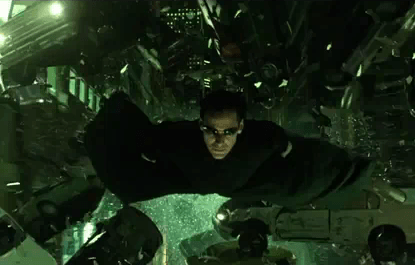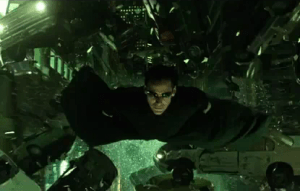
 Archival interview with David Thomson from the official Matrix website.
Archival interview with David Thomson from the official Matrix website.
MATRIX: How did you get into rigging blue and green screens?
DAVID: I work for the Grips Department doing rigging for them, basically cutting light for the camera. I became involved with this because I was a bit of a last man standing; it sort of got thrust upon me. Ray Brown [Supervising Key Grip] showed me the container full of blue screens and talked it up, saying it was going to be a challenging and rewarding role to play. And it has been; it’s been good and it has been hard.
MATRIX: What is your role on a day to day basis?
DAVID: I talk to the Visual Effects Department, to Dan Glass or DJ [John Desjardin, both VFX Supervisors], about the up and coming sets and they’ll tell me what they need to get the shot. At that time, what they need to get the shot may not be the end result of what happens. Parameters change, the Directors change their minds, and the physicality of actually getting a rig in a confined space alters from day to day depending on how often the sets change from sound stage to sound stage.
I put forward a plan of what the green screen is going to look like and how big it’s going to be – depending on what stock we have or how much time we have to order more stock in – and then go to each department for their input. Is this screen going to affect the stunts in any way? Is it going to affect the lighting? What does the Lighting Department need in order to light this? Is it too big to light, or too small? Is there enough room for them to light? We go through a process of elimination until we have the perfect green screen for the stage.
MATRIX: Do the Art Department models help you work out where and how a green screen is going to hang?
DAVID: Yes, particularly if we have the key personnel who can make decisions there at the meetings, they can show us what is going to work. We have a little viewfinder and a little lipstick camera, so we can get down into the models and have a look exactly at what we’re going to be looking at when the set is physically made. That helps a lot, but everyone is so busy it’s hard to get everyone there at the same time to make decisions.
MATRIX: What determines how close it is to the ceiling and to the floor and high it should be?
DAVID: That’s called coverage and is dictated by the shot and camera angle. If I’m coming up to you and you’re looking up, you need the green screen above my head, so the closer I get to camera the higher the green screen has to be.
MATRIX: There are both blue and green screen sets, what determines the screen color on a particular set?
DAVID: For the Matrix all the sets have a green tinge to them, so they’ll shoot everything in that world that needs screens with blue screen. And it’s vice versa in the real world, or Zion – everything has a blue tinge to it, so they shoot everything with green screens. The reason they use green and blue screens is because those colors are very distant from pigment of skin, so they can get ultimate definition. When they pull those colors out of the composite they’re left with as much detail of the skin as possible.
MATRIX: There have been around 150 sets filmed; how many of those had blue or green screen?
DAVID: I could guess, but I’m not sure. I could tell you how much green screen we’ve ordered and you can probably do the math and work it out. We’ve got over seventy five thousand square feet of green screen alone. You can halve that for blue. It works out to about eight square kilometers of green screen… much to the annoyance of those signing the checks. We’ve got three units that all want to shoot and a limited amount of time, so we went through a lot.
We generally make the screens as versatile as we can because if we lock off a green screen in a certain area, you can be pretty sure that when the Directors get there they’ll want to move it. So we try and cater for all eventualities and be as flexible as possible.
MATRIX: Do you have a regular green and blue screen supplier somewhere in the world?
DAVID: Yes, The Rag Place supplied all the blue and Rocket Film Equipment supplied all the green. The Rag Place is in LA and Rocket are here in Australia. They use quite a new type of green screen, it’s not called Tempo, which is the general green screen used around the world, it’s called Veltex. It has a white backing, which cuts down the amount of blue that comes through the green. It’s a very good quality green, but it gets dirty very quickly and very easily.
To clean the screens we use a vacuum cleaner or a dust-buster. The screens originally came with a vacuum cleaner with a nozzle about 20cm wide [about 8 inches], but it took all day to clean just half of one screen. They came back with a few more vacuum cleaners the next time, and they were shampoo vacuum cleaners. I’ve learnt more about green screen and blue screen than I ever thought I would or ever could!
MATRIX: How are the screens hung?
DAVID: They’re all different. We’ve had rear lit screens that were hung just like shower curtains. For others, I’m a Rigger so we just rig up a frame, tie the screen on, fly it up, tension it off, get all the wrinkles out, and there you go. We use weights to get the wrinkles out – it’s all weight and force and tension in the right places.
MATRIX: Earlier you mentioned that all departments had to be happy; how was the distance the screens were hung from the Tenement Roof set decided?
DAVID: After the Stunt Department had given us their parameters, and the Lighting Department had given us their parameters, and accounting for the physical size of the studio, there was only really one place it could hang. That’s generally true for all sets, although some departments will have to compromise to get what they want.
As a rule of thumb, lighting requires half the distance of the height of the screen. If they have a green screen right on set, the type of green that we’ve got is so luminescent that it just spills green, and their lights are such that they spill green all over. So they like to remove the lights as far away off set as they can without compromising the height, because the further away we get, the less coverage we get. The Tenement Rooftop was interesting because the stunt lines actually had to pierce the blue screen all over.
MATRIX: What happens to the screens when the production finishes?
DAVID: They’re all owned by Warner Bros., and I know some of it is going back for the miniature shoot in Alameda later this year. Maybe they’ll sell some of it off in Australia, or maybe they’ll ship it all back to the US.
MATRIX: A lot of sets have blacks screens hanging; what are they?
DAVID: There are two types of black: one is to cut light with the lens, which doesn’t necessarily have to be a very dense black because they are just cutting the light. The other type is to shoot onto, which needs to be so dense that they don’t reflect any light at all so the camera doesn’t pick it up. We have used blacks where there’s a continuation of a cave or a part of a room that’s so dark you’ll never ever see it. So we always ask if the black is it for shoot-off or if it’s just for cutting – the shoot-off ones have to be kept in pristine condition.
Everyone has been pretty good on this film with information, and willing to be flexible in certain things. So long as they’ve got plenty of warning, they’re pretty much happy to help you.
MATRIX: Which set has had the most either green or blue screen?
DAVID: The Zion Siege I imagine. The perimeter of all of Stage 1 has been greened out.
MATRIX: What makes a project interesting for you?
DAVID: It’s a double-edged sword; there has to be problem solving, which means it has to be problematic or difficult to start with. Once you get past that initial hurdle and if you’ve got time to do it, then it’s fun. When you don’t have time to do it – that’s when you start losing your hair.
MATRIX: Are you working alone on the blue screen / green screen side of things?
DAVID: I have a night crew of six and a day crew of six or seven, depending on the days. I also help Roderick Scott out, who is a Senior Rigging Grip, and we build towers and other gripping things. So working for the Grip Department we get called on for other areas as well; I’m not exclusively blue screen or green screen.
MATRIX: Which has been the most challenging set?
DAVID: The egg. From the moment I started, that was the next big thing coming up, so it was only ever six weeks away. We had to research the curtain material: get the right color, get it dyed to the right color, and get the right fabric to start with. We had to get enough of it made and flown in six weeks after doing all the camera tests on it to make sure it was the right light frequency and whatnot. It ended up being six months before we actually shot on it, but no one knew that, so we were always chasing the monkey. The fabricators were pulling their hair out and re-welding the material because it was splitting – they had never ever used that material before either.
It went all the way around the set and had holes in the middle that were little cubicles full of mirrors to reflect blue light, so when you looked into the set you saw blue, huge tuning forks for the stuntmen to fight on, and big walls. There were Perspex floors so people could walk on it without falling through the blue, and it was all lit from behind so the light came through. There were twenty-four hours to go before filming and we came in and half the curtain had been ripped by accident, so we had to rip it off the day before filming, get a new one made that night, and put it up. I think every department had nightmares with that set.
MATRIX: As a Rigger, what other films have you worked on?
DAVID: Working backwards, The Quiet American, Star Wars: Episode II – Attack of the Clones, a few bits and pieces I can’t remember and Moulin Rouge! I came straight from construction rigging into doing this.
MATRIX: How different is construction rigging from green screen rigging?
DAVID: Rigging is a big umbrella: you’ve got your boating rigging, your crane rigging and steel erection, and mechanical rigging. You really have to call on all of those talents in film rigging, although in the real world a lot of Riggers specialize in one area. Every day is different and the problems are never the same, and working at heights is good fun; the day goes quickly.
MATRIX: Thanks David.
Interview by REDPILL
July 2002

Be the first to comment